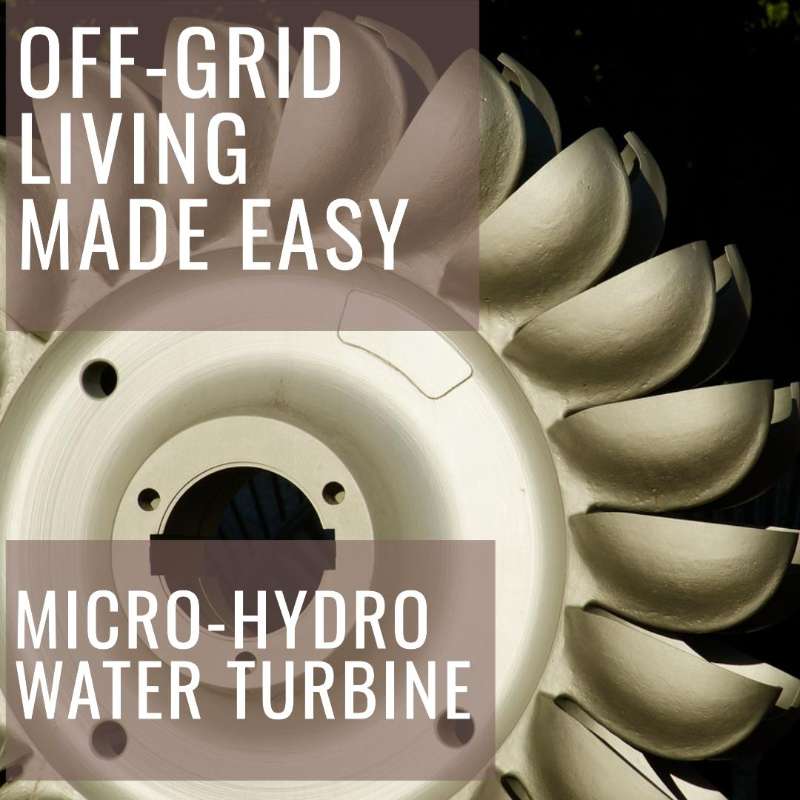Off Grid Living – Micro-Hydro Water Turbine

Make sure to like Living Green and Frugally on Facebook, Shop at Amazon to help support my site and explore our PINTEREST BOARDS for innovative ways you can become self-sufficient.
Exploring Off-Grid Living: Harnessing the Power of Micro-Hydro Water Turbines
In recent years, there has been a growing interest in off-grid living as individuals and communities seek sustainable and self-sufficient alternatives to traditional energy sources. One of the most promising technologies in this regard is the micro-hydro water turbine, a renewable energy solution that harnesses the power of flowing water to generate electricity.
In this article, we delve into the world of off-grid living and explore the potential of micro-hydro water turbines as a reliable and environmentally friendly energy source.
Understanding Off-Grid Living
Off-grid living refers to the lifestyle of living independently from the utility grid, relying instead on self-generated power and resources. This lifestyle choice can be motivated by various factors, including a desire for sustainability, resilience against power outages, and a wish to reduce reliance on fossil fuels.
Off-grid living often involves a combination of renewable energy technologies such as solar panels, wind turbines, and micro-hydro systems, along with energy storage solutions like batteries. Each of these technologies has its advantages and limitations, and the suitability of a particular system depends on factors such as location, available resources, and energy requirements.
The Power of Water: Micro-Hydro Turbines
Among the various renewable energy options available for off-grid living, micro-hydro turbines stand out for their reliability, efficiency, and ability to generate power continuously. These turbines utilize the kinetic energy of flowing water to produce electricity, making them particularly well-suited for locations with access to streams, rivers, or other water sources.
How Micro-Hydro Turbines Work
Micro-hydro turbines operate on the same principles as larger hydroelectric power plants but on a smaller scale. The basic components of a micro-hydro system include:
- Intake Structure: This is where water is diverted from the natural flow of a stream or river into the turbine system. The intake structure must be designed to minimize environmental impact and ensure a consistent flow of water to the turbine.
- Penstock: The penstock is a pipeline that carries water from the intake structure to the turbine. It helps to maintain pressure and regulate the flow of water, optimizing the turbine’s performance.
- Turbine: The turbine is the heart of the micro-hydro system. It converts the kinetic energy of flowing water into mechanical energy, which is then used to drive a generator and produce electricity. There are various types of turbines used in micro-hydro systems, including Pelton, Francis, and Crossflow turbines, each suited to different flow rates and head pressures.
- Generator: The generator is connected to the turbine and converts the mechanical energy into electrical energy. The electricity generated can either be used directly to power appliances or stored in batteries for later use.
- Control System: A control system regulates the operation of the turbine and ensures optimal performance under varying conditions. It may include components such as voltage regulators, load controllers, and safety mechanisms to protect the system from damage.
View this post on Instagram
Advantages of Micro-Hydro Turbines
- Reliability: Unlike solar and wind power, which can be intermittent depending on weather conditions, water flow is generally more consistent, providing a reliable source of energy throughout the year.
- Efficiency: Micro-hydro turbines can achieve high levels of efficiency, especially when designed to match the specific characteristics of the site, such as flow rate and head pressure.
- Low Environmental Impact: Micro-hydro systems have minimal environmental impact when properly designed and installed. They do not produce greenhouse gas emissions and have minimal visual and noise pollution compared to other energy sources.
- Long Lifespan: With proper maintenance, micro-hydro turbines can have a long lifespan, providing a sustainable source of energy for many years.
Considerations for Installation
While micro-hydro turbines offer many benefits for off-grid living, there are several factors to consider when planning and installing a system:
- Site Assessment: A thorough assessment of the site is essential to determine the suitability of the location for a micro-hydro system. Factors such as water flow, head pressure, and environmental impact must be carefully evaluated.
- Regulatory Requirements: Depending on the location, there may be regulatory requirements and permits necessary for installing a micro-hydro system. It’s important to research and comply with local regulations to ensure legal and safe operation.
- Sizing and Design: The size and design of the micro-hydro system should be optimized based on the site’s characteristics and energy requirements. Oversizing or undersizing the system can lead to inefficiencies and reduced performance.
- Maintenance: Regular maintenance is crucial to ensure the continued operation and longevity of the micro-hydro system. This may include inspection of components, cleaning of intake structures, and lubrication of moving parts.
- Cost Considerations: While micro-hydro systems can provide long-term cost savings compared to grid electricity, there are upfront costs associated with installation and maintenance. It’s important to weigh these costs against the potential benefits over the system’s lifespan.
Conclusion
Micro-hydro water turbines represent a promising solution for off-grid living, offering a reliable, efficient, and environmentally friendly source of electricity. By harnessing the power of flowing water, these systems can provide sustainable energy for homes, farms, and remote communities, reducing reliance on fossil fuels and grid infrastructure.
As interest in off-grid living continues to grow, micro-hydro turbines have the potential to play a significant role in powering sustainable communities around the world. With careful planning, design, and installation, micro-hydro systems can provide clean, renewable energy for generations to come, contributing to a more resilient and sustainable future.